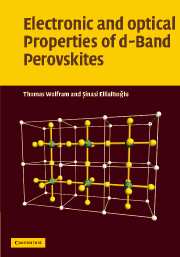Book contents
- Frontmatter
- Contents
- Preface
- 1 Introductory discussion of the perovskites
- 2 Review of the quantum mechanics of N-electron systems
- 3 Empirical LCAO model
- 4 LCAO energy band model for cubic perovskites
- 5 Analysis of bands at symmetry points
- 6 Density of states
- 7 Optical properties of the d-band perovskites
- 8 Photoemission from perovskites
- 9 Surface states on d-band perovskites
- 10 Distorted perovskites
- 11 High-temperature superconductors
- Appendices
- Index
7 - Optical properties of the d-band perovskites
Published online by Cambridge University Press: 23 December 2009
- Frontmatter
- Contents
- Preface
- 1 Introductory discussion of the perovskites
- 2 Review of the quantum mechanics of N-electron systems
- 3 Empirical LCAO model
- 4 LCAO energy band model for cubic perovskites
- 5 Analysis of bands at symmetry points
- 6 Density of states
- 7 Optical properties of the d-band perovskites
- 8 Photoemission from perovskites
- 9 Surface states on d-band perovskites
- 10 Distorted perovskites
- 11 High-temperature superconductors
- Appendices
- Index
Summary
Light interacts with the electrons of a solid through the electromagnetic field associated with the light wave. The electric field exerts an oscillating force on the electrons and ions which produces electronic transitions and other excitations in the solid.
There are several different types of optical adsorption mechanisms for ionic solids such as the perovskites. In the infrared region the electromagnetic field of the photons is strongly coupled to the polarization field of the vibrating ions and “optical” phonons can be created. If the solid is magnetic then adsorption of light can occur due to the excitation of spin waves or magnons. absorption by free electrons (or holes) is also important in the infrared optical region for metallic or semiconducting perovskites. Another important source of absorption is the excitation of plasmons. In doped semiconducting perovskites, plasmon absorption may occur in the infrared region while for metallic materials it is in the visible to ultraviolet region.
Photons with energy greater than the electronic band gap between the highest occupied and the lowest unoccupied bands can cause interband transitions. An interband transition involves the excitation of an electron from a filled valence band to an unoccupied state in another band. For an insulating material interband transitions can occur for photon energy ћω > Eg, where Eg is the fundamental band gap. The optical properties of insulating perovskites in the visible and ultraviolet regions are mainly determined by such interband transitions.
- Type
- Chapter
- Information
- Electronic and Optical Properties of d-Band Perovskites , pp. 138 - 181Publisher: Cambridge University PressPrint publication year: 2006



